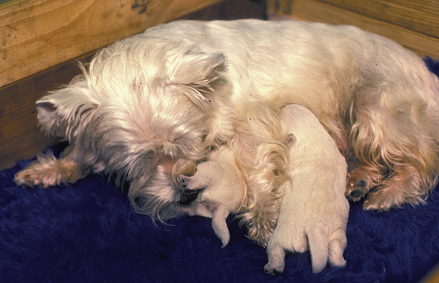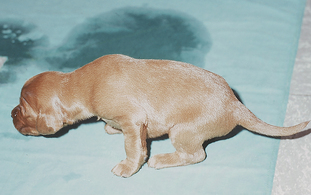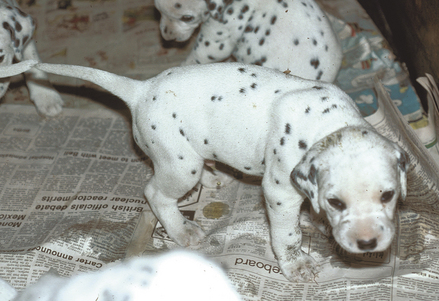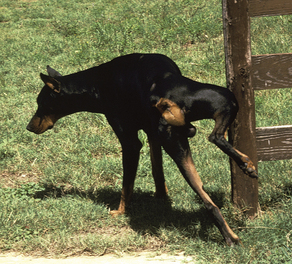CHAPTER 8 Canine Eliminative Behavior
ELIMINATIVE BEHAVIOR DEVELOPMENT
Puppy Behaviors
At birth, a puppy cannot urinate or defecate on its own. The bitch stimulates the puppy’s elimination by licking the caudal abdomen and perineal regions (Fig. 8-1). Her licking triggers the anogenital reflex, resulting in urination or defecation. The anogenital reflex ensures that the bitch is present to ingest the puppy’s waste and keep the nest area clean. While not particularly important in the pet, this behavior helps minimize attraction of potential predators and insect pests to the area in the wild, and it reduces the risk of disease.15,45 Around 2 weeks of age, puppies will start to eliminate on their own, even though the bitch still ingests most of the urine and feces. By 16 to 18 days of age, the anogenital reflex disappears, and maternal stimulation is no longer needed.15,50 Even so, the bitch may continue to catch the puppy’s urine for up to 5.5 weeks and feces up to 9.5 weeks.73
By 3 weeks of age, the puppy is mobile enough to walk to one corner of the nest box or leave it altogether before eliminating.32,73 The location used by puppies of 3 to 5 weeks old is a general area.32,73 Then, by 9 weeks, they use a specific area for eliminations, and in the right situation, this is the same area also used by the bitch.73 The tendency to go to a specific elimination area by 9 weeks is useful in housetraining puppies, and it is apparently a genetically acquired trait.35 In addition to location preferences, substrate, or surface, preferences are learned about the same time.60,73
By 2 months of age, a sexual dimorphism appears in eliminative postures used by puppies.35,73 Females change from a slight squat to a deep squatting posture that remains pretty much unchanged into adulthood (Fig. 8-2).35,56 The very slight squat of a male puppy changes gradually to the male juvenile urination posture.35 This posture is one with the weight shifted slightly forward and rear feet spread somewhat apart (Fig. 8-3).32,35,36,56,73 Around the time of sexual maturity, generally 5 to 8 months of age, the adult male urination posture appears, with the lifted leg and slightly rotated body, allowing the dog to urinate on vertical objects (Fig. 8-4). The scratching behavior that occasionally follows defecation may also begin about this time.56,66 Most owners believe their male dog finally learns to lift his leg for urination, but research indicates the behavior is hormonally controlled and appears when testosterone levels rise.14,31
Experimentally, about half of intact female and neutered female puppies showed leg lifting for urination at 65 to 70 days of age when testosterone injections were started at 3 days of age.4,56 Male puppies showed leg lifting at day 39 when injected with testosterone starting at day 3.31,56 Without the injections, the leg-lifting behavior in male puppies was expressed at an average of 173 days of age.56 Castration after 4 months of age does not change this behavior, but earlier surgery resulted in periodic regression to the immature male posture.4,14,56 Androgens given to the immature male will result in a leg lift, but the leg is more flexed in an adult.14 The behavior reverts to that of the immature dog when testosterone is stopped.73
Occasionally females, especially neutered females, will lift a leg for urination.73 This is usually an abbreviated lift and quite distinct from the typical male posture. Testosterone is produced by male puppies shortly before birth and is responsible for masculinizing the brain to respond to later testosterone elevations. It has been theorized that these female puppies were positioned next to or between male puppies in utero and thus exposed to some level of testosterone.73
Housetraining
Because puppies have a natural tendency to eliminate in specific locations by 9 weeks of age, housetraining a newly acquired puppy is generally quite easy. The primary ingredients needed are patience, praise, confinement, and schedule.11
Patience is necessary because puppies do not become housebroken overnight. They will have accidents for even the most dedicated owner. Some puppies are also slower about learning what is expected, so the owner cannot necessarily expect carpets to be safe after just a few weeks of even concerted effort. Some dogs take a year of consistent handling before they finally become house-safe, and a few others never seem to learn. It is important, however, that owners be consistent in their housetraining program, because deviations can confuse the young dog and delay the learning even more.11 The same holds true for dogs that have been adopted from an animal shelter. Consistency in the training, so that the dog will succeed, and patience while it does are important. Initially just under 75% of the adoptees are housetrained, making soiling the most common postadoption problem.55 A brief counseling session increases the owner’s ability to housetrain their dog in 1 month from 86.4% to 98.1% compared to just handing out educational materials.39
Supervision is the second recommendation for housetraining a dog. Puppies need to be supervised at all times. That either means the owner is actually watching them, or the puppy is confined. Activity triggers eliminative behaviors, so keeping the puppy still is an important management tool. Because puppies have a small urinary bladder and do not concentrate urine well in the kidneys, they generally cannot retain urine after 4 to 5 hours.49 As a rule of thumb a puppy can hold urine for 1 hour for each month of age plus one.38 Therefore, a 3-month-old puppy will need to urinate every 4 hours. They should not be left confined longer than this time, or they will not be able to avoid soiling their bed area. Special arrangements should be made if the owner must be gone for longer times.
The owner who must be gone more than 4 hours should look for alternatives to prolonged crate confinement. It may be possible to leave the puppy in a fenced yard, in a garage, or at a friend’s home. Another alternative would be to keep the pup in an area two or three times larger than a crate, such as a bathroom or a wire- or plywood-framed indoor kennel. In this way the bed area can be separate from a newspaper-covered elimination area.28,37 Any area larger than this, such as the whole house, is not conducive to successful house training.37 When the owners are home, they should take the puppy outside at times when the probability of elimination is high.37
Surfaces used in elimination areas also need to be considered in confinement. Surface preferences are learned between 9 and 24 weeks, so it is best to start the puppy on the same surface type that will be used for the adult dog.11 For most dogs this is grass. It is important that the mats in a crate have a different texture than that of the carpets in the house. Shag throw rugs are out.11 The paper-trained puppy may be fine in a high-rise apartment, but expecting it to change its eliminations to grass a few years later after a move into a house is not realistic. It is also impractical to paper-train the puppy that will grow up to become a 50-lb dog because of the volume and associated odor of the excreta. It is possible to train a dog to use a litterbox for elimination using the same housetraining process. Special litters are available commerically,30,46 but most people will line the litterbox with sod or a disposable pad.
The schedule is the third element of housetraining. Timing is critical, so the schedule used for a puppy becomes important. Puppies normally eliminate when they wake up, after they eat, after activity or excitement, approximately every 2 hours when awake,46 and before bed.* These are the times a puppy should be taken to the elimination site. Because puppies sleep several times a day, they wake up often. They eat three or four meals a day, which should be offered at the same time each day.22,74 Dogs are prandial drinkers, so water intake is associated with meals.46 They then need to urinate 20 to 30 minutes later.46 Thus, more than four trips to the elimination site will be required in the beginning.
For the very young dog, it is desirable to have the owners take the puppy to the elimination site once during the middle of the night. This small investment of a few minutes each night minimizes the risk of accidental soiling when the puppy is least able to hold large volumes of urine and when it does not sleep through the night. After 3 to 4 weeks, the owner can gradually get up 30 to 45 minutes later each night until the puppy can last through an entire night without needing to eliminate. A 7-day-a-week schedule should be maintained for several months so that the expected pattern becomes firmly established. 19,21,67 Owners should never expect their dog, especially a puppy, to ask to go out to eliminate. That behavior can be taught, but not all dogs will pick it up on their own. By using the timing of a schedule, owners are less likely to have problems with housesoiling.
ADULT URINATION
Dogs deposit a lot of urine on the ground each year in the United States. From an estimated dog population of 61.6 million, there is an average urine production of 30 ml/lb (60 ml/kg). Assuming an average dog weight of 25 lb (11.4 kg),13 that amounts to approximately 10.5 million gallons (42.1 million liters) of urine voided each day.
People typically think of three urinary postures in dogs—the squat used by females, the leg-lift with partial squat used occasionally by females, and the male’s raised-leg posture. Sprague and Anisko described eight elimination postures plus another four combination postures (Fig. 8-5).68 Of the twelve, nine have been associated with urination (eight with females and four with males).2,68
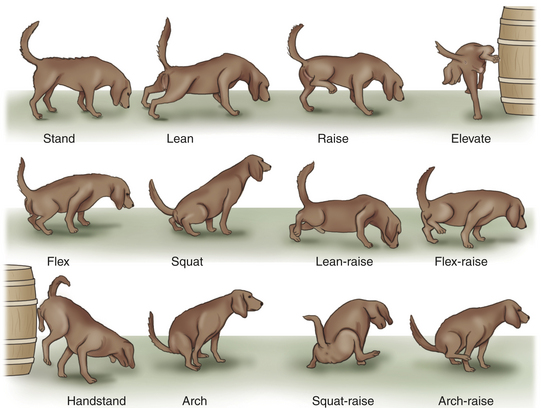
Figure 8-5 The 12 elimination postures used by dogs.
(From reference 68. Used with permission of EJ Brill Publishers.)
In female dogs, 68% of the urinary postures are the squat.16,54,68 Another 19.3% involve a squat and raise, in which the rear limb is raised off the ground but not as high as the horizontal plane.68 Females are more apt to use that posture when away from their home area.76 The raise alone occurs 4.6% of the time, and a slight stifle flex plus a raised rear limb (flex-raise) occurs 3.1% of the time.68 In the elevated position (2.3% of urinary postures), the limb is lifted above the horizontal, necessitating pelvic rotation.68 Other minor postures used by females include a handstand, a flex, and a lean at 1.9%, 0.4%, and 0.4%, respectively.68 For males 97% of the urinary postures involve the typical male posture of elevation.16, 54, 68 An occasional male will use a raised posture (2.1%), a squat-raise posture (0.6%), or a lean-raise posture (0.3%).68
Male urinations are directed toward vertical targets 97.6% of the time, but 15% of the time the dog urinates on the ground for at least a while.68 Males that urinate on the ground instead of vertical objects use an elevated leg posture only 9% of the time; the rest of the time they use a raised-leg posture (52%) or some variant of the raised-leg posture (lean-raise 13% and squat-raise 26%).68 When a male dog does use a raised-leg posture or a variant of it, he urinates on the ground instead of against a vertical object 60% of the time.68 Males almost always sniff the ground or an object before and/or during urinating.2,68 They also urinate where another male has urinated.68 When not on leashes, male dogs are responsible for most urinations in public places,64 because they urinate three to four times more often than do females. Castration decreases the frequency to approximately that of a female.2,14,54,56 Males that are sick, anxious, or stressed may temporarily use a squatting posture for urination.31,32
For female dogs, the urinations are usually on the ground, except for the 11.6% that are oriented against a vertical object.68 Of the female dogs, 13.2% urinate on a vertical object at least once, and 3.8% never urinate on the ground at all.68 Females urinate less often than males and probably use urination mainly to empty their urinary bladder.35,56 At least in certain breeds, female urinations may have a significant marking function.76 The frequency increases during estrus.2
In both sexes, “pseudourination” motions may be made during which all the behaviors of urination are performed but no urine voided.68 In males, the behavior is called a raised-leg display.54 Both males and females are less active in urination when another dog is in view, but both hold a posture longer without actual urination. The female squat-urinates longer, and the male may remain in a squat-raise posture longer.54
Submissive urination occurs when the dog is showing one or more body postures associated with submission. In this case, the dog is not in a typical eliminative posture, but instead may be standing, crouching, or even lying down. Submissive urination is commonly shown by puppies and very submissive dogs to a dominant person. Punishment is inappropriate, because it usually makes the behavior worse—the dog is already showing submission.10 Instead the best approach is to ignore the behavior.72 Other techniques to use with these dogs include greeting the dog outdoors where the behavior will not soil the house, avoiding the situations that produce the behavior, redirecting the dog’s attention from the greeting to playing with a ball, keeping the greeting low key, ignoring the behavior, or using food to countercondition the dog to stand.10,69,70,72 Phenylpropanolamine may be useful to tighten the urinary bladder sphincter,10,46 but most dogs will outgrow submissive urination by sexual maturity.10,70 The incidence of the behavior can be reduced by regular handling of puppies from birth to 16 weeks of age.79
Outside factors influence eliminative behavior. Although the size of an area the dog stays in has minimal effect on where it eliminates, structural irregularities, such as exposed pipes, have an effect.58 Dogs eliminate near them. They also have a tendency to eliminate as far from food and water as confinement allows.58 Other stimuli for urination include fresh urine of another dog, excreta from birds and other animals, oil, tobacco,25 and anise oil.58 Stress and anticipation of a reward cause an increase in arterial blood pressure and a preglomerular resistance, with a resulting decrease in urine flow rate.52,63
Urine marking is another form of urination, but it is intended to call attention to a location or cover over another scent rather than empty the bladder. Some species, like cats, use a unique posture to leave the odor at nose height. In dogs, the elevated leg posture of male urination already accomplishes that. As most intact male dogs tend to urinate more often than other dogs and void small amounts each time instead of completely emptying their bladder in one location, urine marking probably is part of each urination.35
Marking is also a male sexually dimorphic behavior.27,35 Females in estrus show an increased tendency to urine mark also.27 When male dogs roam free, they routinely check certain scent posts daily, but they do not appear to systematically mark territorial boundaries.35 These dogs do not show fearful responses to urine marks from other dogs, so the purpose of a urine mark is apparently for individual identification, much like a calling card, or for orientation within an area, keeping track of different individuals within an area, sexual stimulation, or giving familiarity to an area.35,51,73 When a dog is put in a pen that previously contained other dogs, the new dog will urinate almost 25 times in the first 2 hours.35 For the next few days thereafter, the frequency of urination is reduced to between two and five marks per 2-hour period.35 When presented with its own urine, urine from a known male, or urine from an unknown male, the dog being tested will spend two times longer with the known male urine and four times longer with the unknown sample than with their own urine.29 Male dogs often will urinate in sight of each other and then investigate the other dog’s urine scent.73 They also tend to mark a couple of times over the urine of a familiar male versus four times over that of a stranger.73
